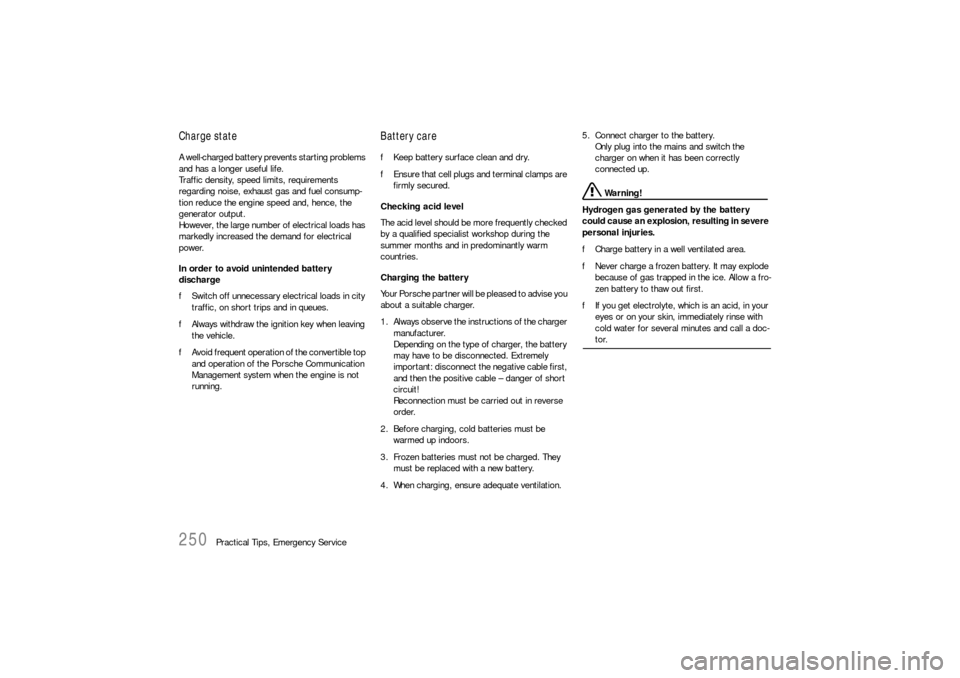Page 250 of 296

250
Practical Tips, Emergency Service
Charge stateA well-charged battery prevents starting problems
and has a longer useful life.
Traffic density, speed limits, requirements
regarding noise, exhaust gas and fuel consump-
tion reduce the engine speed and, hence, the
generator output.
However, the large number of electrical loads has
markedly increased the demand for electrical
power.
In order to avoid unintended battery
discharge
fSwitch off unnecessary electrical loads in city
traffic, on short trips and in queues.
fAlways withdraw the ignition key when leaving
the vehicle.
fAvoid frequent operation of the convertible top
and operation of the Porsche Communication
Management system when the engine is not
running.
Battery carefKeep battery surface clean and dry.
fEnsure that cell plugs and terminal clamps are
firmly secured.
Checking acid level
The acid level should be more frequently checked
by a qualified specialist workshop during the
summer months and in predominantly warm
countries.
Charging the battery
Your Porsche partner will be pleased to advise you
about a suitable charger.
1. Always observe the instructions of the charger
manufacturer.
Depending on the type of charger, the battery
may have to be disconnected. Extremely
important: disconnect the negative cable first,
and then the positive cable – danger of short
circuit!
Reconnection must be carried out in reverse
order.
2. Before charging, cold batteries must be
warmed up indoors.
3. Frozen batteries must not be charged. They
must be replaced with a new battery.
4. When charging, ensure adequate ventilation. 5. Connect charger to the battery.
Only plug into the mains and switch the
charger on when it has been correctly
connected up.
Warning!
Hydrogen gas generated by the battery
could cause an explosion, resulting in severe
personal injuries.
fCharge battery in a well ventilated area.
fNever charge a frozen battery. It may explode
because of gas trapped in the ice. Allow a fro-
zen battery to thaw out first.
fIf you get electrolyte, which is an acid, in your
eyes or on your skin, immediately rinse with
cold water for several minutes and call a doc-tor.
Page 252 of 296

252
Practical Tips, Emergency Service
Putting vehicle into operationAfter the battery is connected or after an exhaus-
tively discharged battery is charged, the multi-
functional PSM light lights up on the instrument
panel and a message appears on the on-board
computer to indicate a fault.
This fault can be remedied with a few simple
steps:
1. Start the engine.
2. With the vehicle stationary, perform a few
steering movements to the left and right and
then drive a short distance in a straight line
until the multifunctinal PSM light goes out and
the message on the on-board computer
disappears.
3. If the warnings do not disappear, then:
Drive carefully to the nearest qualified
specialist workshop.
Have the fault remedied.
4. After the warnings disappear, stop the vehicle
in a suitable place.
5. Perform adaptation of the power windows:
Please observe the chapter “STORING END
POSITION OF THE WINDOWS” on Page 29.Ignition key/ignition lock
fDo not insert the ignition key into the ignition
lock if the vehicle battery is discharged.
The ignition key can no longer be removed.
The key cannot be removed until the vehicle elec-
trical system is supplied with power again.
fPlease observe the chapter “EMERGENCY UN-
LOCKING OF THE FRONT LUGGAGE COMPART-
MENT LID” on Page 248.
6. Please observe the chapter “JUMP LEAD
STARTING” on Page 256.
Page 253 of 296
Practical Tips, Emergency Service
253
Removing the batteryThe battery is located in the luggage compart-
ment under a black plastic lid.
1. Switch off engine and all electrical loads.
2. Open turn-locks A.
Remove plastic lid.
Warning!
Risk of damage to generator and electronic
control units.
fDo not disconnect battery while the engine is
running.
Risk of caustic burns from escaping acid.
fDo not tilt the battery when removing it.
3. Pull off vent hose C.
4. Important: disconnect the negative lead first,
and then the positive lead – danger of short
circuit!
5. Unscrew fastening screw B.
6. Remove battery.
Page 256 of 296

256
Practical Tips, Emergency Service
Jump lead startingfPlease observe the chapter “EMERGENCY
UNLOCKING OF THE FRONT LUGGAGE
COMPARTMENT LID” on Page 248.
fPlease observe the chapter “BATTERY” on
Page 249.
If the battery is flat, the battery of another vehicle
can be used to start the car with the aid of jump
leads.
Both batteries must be 12 volt types. The
capacity (Ampere hours, Ah) of the donor battery
must not be substantially less than that of the
discharged battery.
The discharged battery must be correctly
connected to the vehicle’s electrical system.
Warning!
Risk of damage and injury due to short
circuit.
fUse only standard jump leads with sufficient
cross section and completely insulated
clamps.
Follow the jump lead manufacturer’s instruc-
tions.
fRoute the jump leads so that they cannot be
caught by moving parts in the engine compart-
ment.
The vehicles must not be in contact, otherwise
current might flow as soon as the positive
terminals are connected.
fCarefully ensure that conductive jewellery
(rings, chains, watch straps) do not come into
contact with live parts of the vehicle.
Danger of caustic burns.
fDo not lean over the battery.
Danger of gas explosion.
fKeep sources of ignition, e.g. naked flame,
burning cigarettes or sparks due to cable
contact, away from the battery.
fBefore connecting jump leads, it is essential to thaw out a frozen battery.
Connecting jump leadsAlways observe the sequence below:
1. Connect the red positive lead to the positive
terminal of the discharged battery first, then
connect it to the positive terminal of the donor
battery.
2. First connect the black negative cable to the
negative terminal of the donor battery, then
connect it to a suitable grounding point on the
vehicle with the discharged battery.
This grounding point must lie as far as possible
from the battery.
For example, a solid metal part or the engine
block are suitable grounding points.
If no suitable grounding points are to be found
on either vehicle, the negative cable must
carefully be connected directly to the negative
terminal of the battery.
If a suitable grounding point is to be found only
on the donor vehicle, the negative cable must
first be connected to the terminal of the
discharged battery, then to the grounding point
of the donor vehicle.
Page 257 of 296
Practical Tips, Emergency Service
257
3. Run the engine of the donor car at a higher
speed.
4. Start the engine.
An attempted start using jump leads should
not last more than 15 seconds. Then allow a
waiting period of at least one minute.
5.Note
Before disconnecting the jump leads, electrical
loads such as the heated rear window and the
heating fan blower should be switched on (the
vehicle’s lights must not be switched on). This
reduces voltage peaks which may occur when
disconnecting the jump leads.
With the engine running, remove both jump
leads in reverse order.
Page 278 of 296

278
Vehicle Identification, Technical Data
Vehicle IdentificationWhen ordering spare parts or making inquiries,
please always quote the vehicle identification num-
ber. Vehicle data bankThe vehicle data bank is attached to the inside of
the ”Maintenance“ booklet.
It contains all important data about your car.
Note
This data bank cannot be re-ordered if it is lost or
damaged.
This label contains the following information:
1. Vehicle Identification No.
2. Type/Type description
3. Engine code/Transmission code
4. Paint No./Interior
Vehicle identification number In accordance with Federal Safety Regulations,
the vehicle identification number of your car is lo-
cated at the bottom left of the windshield frame
and can be seen from the outside.
The vehicle identification number is in the front lug-
gage compartment under the battery cover and at
the bottom left behind the windshield.
Removing the battery cover
fPlease observe the chapter “BATTERY” on
Page 249.
Safety compliance sticker The safety compliance sticker is your assurance
that your new Porsche complies with all applicable
Federal Motor Vehicle Safety Standards which
were in effect at the time the vehicle was manuf-
actured.
The sticker also shows the month and year of pro-
duction and the vehicle identification number of
your car (perforations) as well as the Gross Vehic-
le Weight Rating and the Gross Axle Weight Ra-
ting.
Page 279 of 296
Vehicle Identification, Technical Data
279
Tire pressure plateThe tire pressure plate is attached to the left-hand
door aperture.
Engine number The engine number is stamped on the underside
of the crankcase.
Page 280 of 296
280
Vehicle Identification, Technical Data
Technical DataEngine data
Boxster Boxster S
Type M 96/25 M 96/26
Horizontally opposed engine, liquid cooledHorizontally opposed engine, liquid cooled
Number of cylinders 6 6
Bore 3.37 in./85.5 mm 3.66 in./93 mm
Stroke 3.07 in./78 mm 3.07 in./78 mm
Cubic capacity 163.96 cu. in./2687 cm
3 193.98 cu. in./3179 cm
3
Net-horsepower, SAE J 1349 240 hp/176 kW 280 hp/206 kW
at crankshaft speed 6400 rpm 6200 rpm
Net torque, SAE J 1349 199 ft. lb./270 Nm 236 ft. lb./320 Nm
at crankshaft speed 4700 - 6000 rpm 4700 - 6000rpm
Alternator 2100 W 2100 W
Firing order 1 - 6 - 2 - 4 - 3 - 5 1 - 6 - 2 - 4 - 3 - 5
Engine control Stationary high-voltage distribution, sequential injection,
cylinder-selective knock-control, stereo oxygen sensor closed-loop control, diagnostic system,
4 overhead camshafts, Porsche VarioCam, hydraulic valve clearance compensation